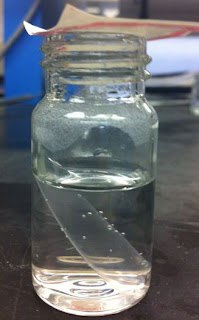First, the puncture test was attempted using a home-made device of plastic cups, a funnel, tape, cardboard, a pen, and a large bottle of water. A diagram of this testing deice is shown below. During the test, water was gradually poured into the large bottle of water at the top of the device, and the blunt end of the pen was pushed down upon a film that was taped to the edges of a lidded plastic cup. Although the device did work in applying pressure to the films, the weight of the water in the large bottle was not sufficient to puncture the films. Using larger bottles for the water came with a risk of compromising the accuracy and stability of the testing device. Therefore, it was decided to attempt to use a lab machine to perform the puncture test on the films.
Puncture Test Device:
In addition to film testing, two additional 60% starch films were synthesized for testing and demonstration purposes. Also, the results of the biodegradability tests were analyzed after the films were left in the water-filled vials for 8 days. As predicted, there was a clear correlation between increasing starch content and increasing biodegradability. The films with higher starch content in the water-filled vials had partially degraded into smaller white particles that were visible in the bottom of the vials.


No comments:
Post a Comment